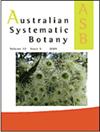澳大拉西亚蕨类植物Pellaea(蕨类科)综述
IF 1.6
3区 生物学
Q4 EVOLUTIONARY BIOLOGY
引用次数: 3
摘要
摘要澳大拉西亚Pellaea的五个本土物种属于Platyloma剖面。概述了它们的分类历史,回顾了识别它们的形态学、细胞学和遗传学证据,并提供了新的形态学和叶绿体DNA序列数据。澳大利亚的镰孢属植物(R.Br.)Fée是二倍体,羽片比以前称为镰孢属的新西兰植物更长、更窄,后者是四倍体。有证据表明,P.falcata在新西兰没有出现,因此命名的藏品是圆叶P.Forst.Hook。叶绿体DNA序列在区分澳大利亚镰刀豆和新西兰圆叶豆方面没有信息,但表明澳大利亚楠与两者不同。序列数据还表明,澳大利亚和新西兰的P.calidirupiumBrownsey和Lovis种群关系密切,澳大利亚P.paradoxa(R.Br.)Hook种群关系密切。与其他澳大利亚物种不同。虽然镰孢霉是二倍体,圆叶霉是四倍体,但杯花霉、南花霉(胡克)Bostock和悖论霉都含有多倍体水平。Pellaea物种的二倍体种群仅限于澳大利亚,在新西兰只知道四倍体。该群体的进化可能涉及杂交、自噬、异倍性,以及可能的无融合生殖。需要进一步调查,以确定马龙山、昆士兰和克马德克群岛的人口状况。本文章由计算机程序翻译,如有差异,请以英文原文为准。
A review of the fern genus Pellaea (Pteridaceae) in Australasia
Abstract. Five indigenous species of Pellaea in Australasia belong to section Platyloma. Their taxonomic history is outlined, morphological, cytological and genetic evidence for their recognition reviewed, and new morphological and chloroplast DNA-sequence data provided. Australian plants of P. falcata (R.Br.) Fée are diploid and have longer, narrower pinnae than do New Zealand plants previously referred to P. falcata, which are tetraploid. Evidence indicates that P. falcata does not occur in New Zealand, and that collections so-named are P. rotundifolia (G.Forst.) Hook. Chloroplast DNA sequences are uninformative in distinguishing Australian P. falcata from New Zealand P. rotundifolia, but show that Australian P. nana is distinct from both. Sequence data also show that Australian and New Zealand populations of P. calidirupium Brownsey & Lovis are closely related, and that Australian P. paradoxa (R.Br.) Hook. is distinct from other Australian species. Although P. falcata is diploid and P. rotundifolia tetraploid, P. calidirupium, P. nana (Hook.) Bostock and P. paradoxa each contain multiple ploidy levels. Diploid populations of Pellaea species are confined to Australia, and only tetraploids are known in New Zealand. Evolution of the group probably involved hybridisation, autoploidy, alloploidy, and possibly apomixis. Further investigation is required to resolve the status of populations from Mount Maroon, Queensland and the Kermadec Islands.
求助全文
通过发布文献求助,成功后即可免费获取论文全文。
去求助
来源期刊

Australian Systematic Botany
生物-进化生物学
CiteScore
3.10
自引率
12.50%
发文量
12
审稿时长
>12 weeks
期刊介绍:
Australian Systematic Botany is an international journal devoted to the systematics, taxonomy, and related aspects of biogeography and evolution of all algae, fungi and plants, including fossils. Descriptive taxonomic papers should normally constitute a comprehensive treatment of a group. Short papers on individual species and nomenclatural papers must contain significant new information of broader interest to be considered. The prestigious L.A.S. Johnson Review Series is published. Other review articles will also be considered. All papers are peer reviewed.
Australian Systematic Botany is published with the endorsement of the Commonwealth Scientific and Industrial Research Organisation (CSIRO) and the Australian Academy of Science.
 求助内容:
求助内容: 应助结果提醒方式:
应助结果提醒方式:


